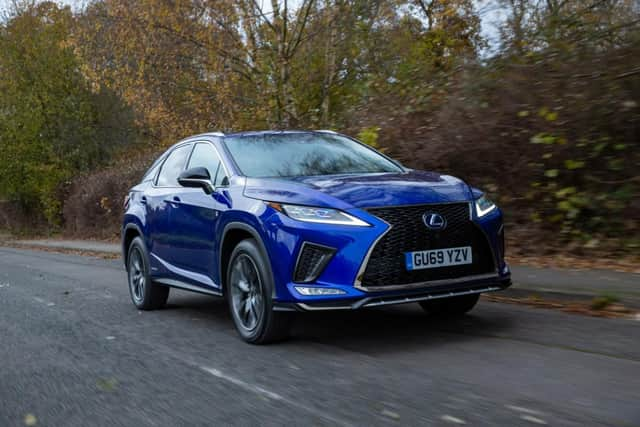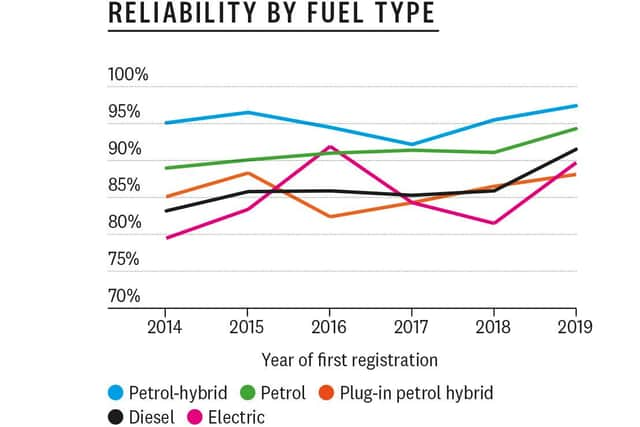Are hybrid cars reliable? How petrol-electric models compare to petrol and diesel for mechanical failure


Hybrid cars are a rapidly growing part of the UK’s motoring landscape.
Diesel is falling out of favour and all-electric cars have not yet become mainstream, so manufacturers are looking for other ways to reduce CO2 emissions and improve economy.
Advertisement
Hide AdAdvertisement
Hide AdMany are turning to hybrids as a low-emission option, where a petrol or diesel engine is paired with some form of electric drive. Whether you’re looking for a supermini like the Honda Jazz, a family hatchback like the Toyota Corolla or an SUV like the Volvo XC60, there’s likely to be a hybrid version on sale. And registration figures show their popularity is rising, with all forms of hybrids enjoying well above average increases in August.


But with two (or more) motors and lots of additional electronics it might seem likely that they’ll also pack in more problems.
However a new study by Which? suggests that so-called self-charging hybrids are actually more reliable than other types of drivetrains.
The consumer group gathered individual data on more than 55,000 vehicles from owners to compare reliability between petrol, diesel, full hybrid, plug-in hybrid and pure-electric cars.


It found that less than three per cent of full hybrid owners had needed to seek mechanical assistance for their car in the last year. That compares with six per cent of petrol car owners and 10 per cent of both diesel and EV owners. Plug-in hybrids proved least reliable but still less than 15 per cent of drivers suffered a problem with their car.
Why are hybrids more reliable?
Despite the apparent extra complexity of a hybrid drivetrain, Which?’s experts have suggested the differences to a petrol or diesel system could actually make them more resistant to failure.
Hybrids generally use a CVT transmission which doesn’t have a clutch and never disengages so is more resistant to wear.
The electric motor also has few moving parts and assists the petrol in heavy-demand situations, meaning the engine doesn’t have to work as hard, which can increase longevity.
Advertisement
Hide AdAdvertisement
Hide AdThe truly complicated part of hybrid systems are the power inverter (a non-moving part) and the software that controls it all.
Harry Rose, Editor of Which? Magazine, commented: “It’s great to see so few people reporting issues with their petrol-electric hybrid car. Despite the complexities of two motors working in harmony, they are mechanically simpler than conventional petrol or diesel cars, which is good news for motorists as it reduces the likelihood of problems.
"While our research shows electric cars and plug-in hybrids are still less dependable than other fuel types, we expect to see their reliability improve as these markets establish themselves. Thanks to more challenging CO2 regulations, we're seeing more choice and in the future, we will have a lot more models to report on."
What are the different types of hybrid?
There are three main types of hybrid - mild hybrid (MHEV), full hybrid and plug-in hybrid (PHEV).
Mild hybrids, such as the Fiat Panda hybrid, use an integrated starter motor/generator and small battery. They can’t operate independently of the engine but offer a small boost in torque under acceleration or can allow the engine to cut out when coasting.
Full hybrids, such as the Toyota Prius or Lexus RX, are also sometimes known as self-charging hybrids. They feature a larger battery and more powerful electric motor that is capable of powering the car on its own. It can be used to drive the car, particularly around town or to give assistance to the engine when it is at its least efficient, such as when setting off. Their batteries are charged via energy recuperation from braking/decelerating and via the combustion engine in low-load situations.
Plug-in hybrids like the Vauxhall Grandland X or Mitsubishi Outlander are similar to full hybrids but have larger batteries that can be charged via the same methods or by plugging them into a home or public charging point (the same chargers as used by EVs). Their larger batteries allow most PHEVs to cover between 20 and 40 miles on electric power per charge. Once the battery is depleted, they work in the same way as a full hybrid.